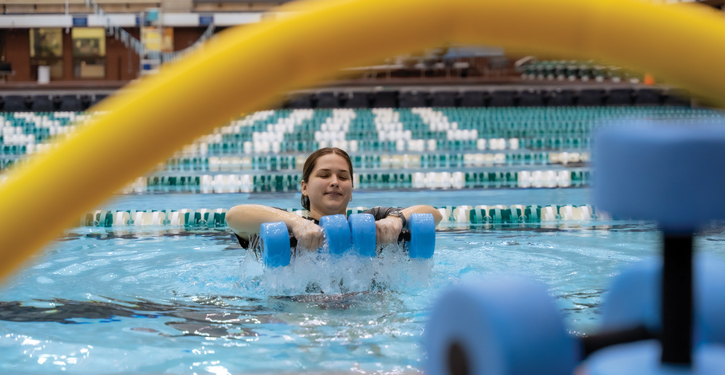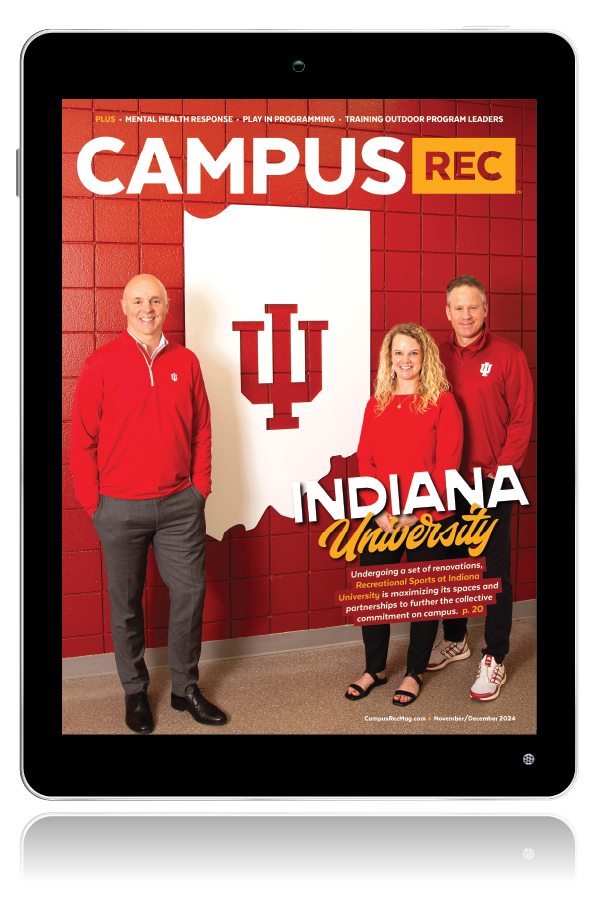Aquatics is a unique area of programming as it transcends many traditional divides. Anyone can learn to swim no matter their location, ability level, socio-economic status or other demographics they belong to. As such, swim programs are a common programming pillar for campus rec and valuable vehicle for connections.
For example, Cleveland State University (CSU) and other CENTERS schools offer learn-to-swim lessons which help University Recreation and Wellbeing connect with international students and professors. Ensuring these programs remain economically accessible is also important.
“It’s really cool to be able to provide these skills for different populations,” said Michelle Rieger, the senior associate director at CENTERS LLC at CSU. “Not every country or community area has access to swim lessons. We really try to make sure we have as many programs as we can for drowning prevention and learn-to-swim. CENTERS has a number of urban sites — including CSU — and we do have water, but we need to make sure kids know what to do with it.”
Swimming is such a foundational life skill, it’s a graduation requirement at the Massachusetts Institute of Technology (MIT). Students can either take a learn-to-swim class or demonstrate the ability to swim at least 100 yards and then take another PE class to fulfill this credit. Ben McElhiney, the associate director of Aquatics and Risk Management, explained how the First Year Swim Test is actually a big event for MIT Recreation.
From there, MIT works to increase belonging and accessibility in aquatics spaces. One example of how they do this is through specialized swim times for different populations. Currently, Recreation runs a women-only swim for one hour a week. Originally, its focus was religion-orientated but has since morphed into being a safe place for anyone who identifies as a woman to enjoy the pool. It’s also looking to add adaptive aquatics opportunities and lessons in the near future.
EXTRA CREDIT: Check out this exercise for teaching inclusive aquatics.
Even if the department can’t capitalize on trends now, it’s always keeping an eye on topics making a splash locally and nationally. In fact, McElhiney noted a focus on improving the accessibility of aquatics which the Recreation department is consistently working toward bettering.
Especially for underrepresented demographics, McElhiney emphasized campus rec’s role in better serving these groups. “Historically, these populations have been let down, both in the U.S. and globally,” said McElhiney. “It’s something that’s deeply rooted in racial biases, and we’re trying to break down these barriers as much as we can. The youth level is the best starting point.”
Branching your aquatics programming out to greater community members — especially learn-to-swim programs for kids — can be extremely beneficial for your rec center. MIT offers American Red Cross training from parent-infant level through level five, which helps create touchpoints in the local populations and bring in extra revenue.
Similarly, offering youth programming is how another university is becoming an aquatics powerhouse in its community. Alyssa Owens, the director of aquatics and safety at Abilene Christian University (ACU), has done just that by making ACU a hub for aquatics programming for the entire community. Located in the small town of Abilene, Texas, locals appreciate the multiple offerings ACU provides for both children and adults.
Particularly, Owens has noticed an increase in demand for private swim lessons which ACU offers year-round. One potential reason why is that other local organizations offering swim lessons push their group lessons. Parents in the community are moving away from group offerings after noticing their child not thriving in this setting. As such, this allows ACU to serve them with private instruction.
EXTRA CREDIT: Addressing disparities and improving access to swim programs.
“We can tailor private lessons to the child or even adults’ progress at the speed they’re going instead of having them try to keep up with a group or be put at a disadvantage if they’re way past the group,” said Owens. “They progress on their timeline and get more one-on-one attention. Sometimes they progress quicker than they would in a group lesson.”
Another area of programming open to the public is lifeguard training. Many facilities are facing shortages in these positions and are offering certification opportunities. ACU is one example, but it offers these courses for the community no matter where they decide to work. Doing so may not alleviate staffing shortages at the university, but Owens noted the benefits for the community.
“We’re happy to unbiasedly train lifeguards for the pools here in Abilene,” explained Owens. “Our goal with training lifeguards has always been to help everyone else in the area because Abilene is kind of secluded. I wanted to create a hub where if you want to be trained locally to work locally, we do it here year-round. It may not be the best business model, but I feel it’s our duty to give back to the community.”
A strategy Owens employs to combat the lifeguard and swim instructor shortage is finding ways to encourage growth and development in their positions. She puts student staff in leadership roles which gets them better pay and increases their engagement with the role.
EXTRA CREDIT: More insight on overcoming the lifeguard shortage.
“Students can learn a lot in these roles,” said Owens. “They’ll learn valuable life lessons and help operations run smoother. We’ve actually been able to expand our programming because of them which is how we’ve combatted being short-staffed.”
Highlighting the unique aspects of working in aquatics can be valuable for both part-time and full-time staff. Rieger highlighted the versatility of the field for professionals. “Working in aquatics is amazing because you get to work on the programming side and see people’s progress as they navigate different skill levels,” she said. “Sometimes it’s breaking through mental or physical barriers. But you also get to deal with the facility side of things with cleaning, maintenance and making sure chemicals are where they need to be.”
The universal appeal of these spaces has made it a pillar in campus rec. Any user or professional can enjoy the programming that takes place here, and it won’t be going away anytime soon.
“Aquatics is something that will never go away,” said Rieger. “Even if pools are closing, there’s still lakes, rivers and other bodies of water. We need to make sure people are safe in and around water.”










